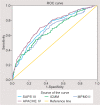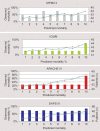Evaluation and Validation of Four Scoring Systems: the APACHE IV, SAPS III, MPM0 II, and ICMM in Critically Ill Cancer Patients
- PMID: 32565637
- PMCID: PMC7297244
- DOI: 10.5005/jp-journals-10071-23407
Evaluation and Validation of Four Scoring Systems: the APACHE IV, SAPS III, MPM0 II, and ICMM in Critically Ill Cancer Patients
Abstract
Background and aims: To evaluate and validate four severity-of-illness scores, acute physiology and chronic health evaluation IV (APACHE IV), simplified acute physiology score III (SAPS III), mortality probability models II at 0 hours (MPM0 II), and ICU cancer mortality model (ICMM), in a prospective cohort of critically ill cancer patients.
Materials and methods: Single-center, prospective observational study performed in a 14-bedded combined medical-surgical ICU of a tertiary care cancer center of India, from July 2014 to November 2015. Score performance was judged by discrimination and calibration, using the area under receiver-operating characteristics (ROC) curve and Hosmer-Lemeshow goodness-of-fit test, respectively.
Results: A total of 431 patients were included in the study. Intensive care unit (ICU) and hospital mortality were 37.4% and 41.1%, respectively. The area under ROC curve for APACHE IV, SAPS III, MPM0 II, and ICMM were 0.73, 0.70, 0.67, and 0.67, respectively. Calibration as calculated by Hosmer-Lemeshow analysis type C statistics for APACHE IV, SAPS III, MPM0 II, and ICMM shows good calibration with Chi-square values of 5.32, 9.285, 9.873, and 9.855 and p values of 0.723, 0.319, 0.274, and 0.275, respectively.
Conclusion: All the four models had moderate discrimination and good calibration. However, none of the mortality prediction models could accurately discriminate between survivors and nonsurvivors in our patients.
How to cite this article: Siddiqui SS, Narkhede AM, Kulkarni AP, Prabu NR, Chaudhari HK, Divatia JV, et al. Evaluation and Validation of Four Scoring Systems: the APACHE IV, SAPS III, MPM0 II, and ICMM in Critically Ill Cancer Patients. Indian J Crit Care Med 2020;24(4):263-269.
Keywords: Acute physiology and chronic health evaluation IV; Cancer; Intensive care unit cancer mortality model; Intensive care unit mortality; Intensive care unit outcome; Mortality probability models II at 0 hours; Severity-of-illness scoring systems; Simplified acute physiology score 3.
Copyright © 2020; Jaypee Brothers Medical Publishers (P) Ltd.
Conflict of interest statement
Source of support: Nil Conflict of interest: None
Figures
Similar articles
-
Performance of APACHE IV in Medical Intensive Care Unit Patients: Comparisons with APACHE II, SAPS 3, and MPM0 III.Acute Crit Care. 2018 Nov;33(4):216-221. doi: 10.4266/acc.2018.00178. Epub 2018 Nov 21. Acute Crit Care. 2018. PMID: 31723888 Free PMC article.
-
Assessment of the performance of five intensive care scoring models within a large Scottish database.Crit Care Med. 2000 Jun;28(6):1820-7. doi: 10.1097/00003246-200006000-00023. Crit Care Med. 2000. PMID: 10890627
-
Performance in mortality prediction of SAPS 3 And MPM-III scores among adult patients admitted to the ICU of a private tertiary referral hospital in Tanzania: a retrospective cohort study.PeerJ. 2021 Nov 16;9:e12332. doi: 10.7717/peerj.12332. eCollection 2021. PeerJ. 2021. PMID: 34820169 Free PMC article.
-
The Simplified Acute Physiology Score III Is Superior to the Simplified Acute Physiology Score II and Acute Physiology and Chronic Health Evaluation II in Predicting Surgical and ICU Mortality in the "Oldest Old".Curr Gerontol Geriatr Res. 2014;2014:934852. doi: 10.1155/2014/934852. Epub 2014 Feb 17. Curr Gerontol Geriatr Res. 2014. PMID: 24696680 Free PMC article. Review.
-
ICU severity of illness scores: APACHE, SAPS and MPM.Curr Opin Crit Care. 2014 Oct;20(5):557-65. doi: 10.1097/MCC.0000000000000135. Curr Opin Crit Care. 2014. PMID: 25137401 Review.
Cited by
-
Epidemiology, Clinical Characteristics, and Prognostic Factors in Critically Ill Patients with Hematolymphoid Malignancy.Indian J Crit Care Med. 2021 Jan;25(1):56-61. doi: 10.5005/jp-journals-10071-23469. Indian J Crit Care Med. 2021. PMID: 33603303 Free PMC article.
-
Ideal Severity of Illness Scoring System for Critically Ill Cancer Patients: A Dream.Indian J Crit Care Med. 2020 Apr;24(4):215. doi: 10.5005/jp-journals-10071-23405. Indian J Crit Care Med. 2020. PMID: 32565628 Free PMC article.
-
Identifying early-measured variables associated with APACHE IVa providing incorrect in-hospital mortality predictions for critical care patients.Sci Rep. 2021 Nov 12;11(1):22203. doi: 10.1038/s41598-021-01290-7. Sci Rep. 2021. PMID: 34772961 Free PMC article.
References
LinkOut - more resources
Full Text Sources




